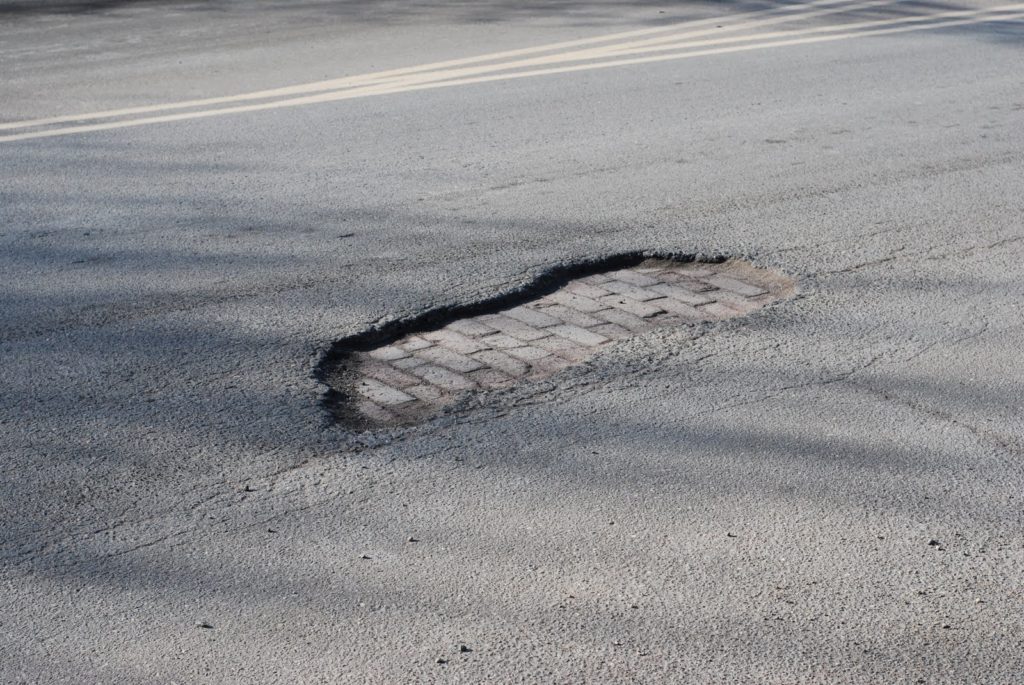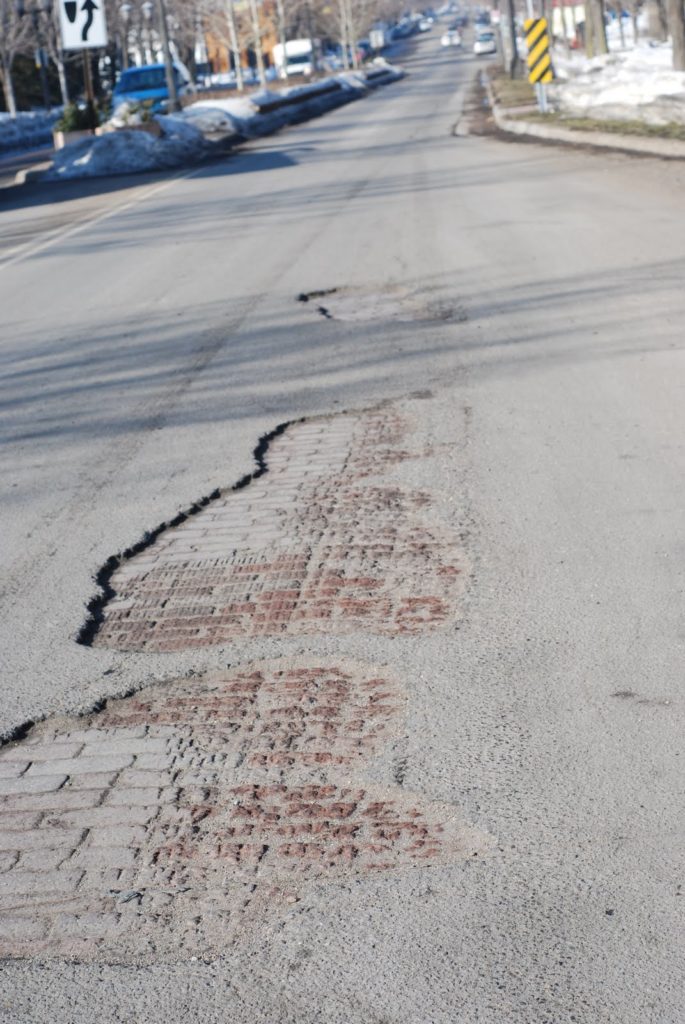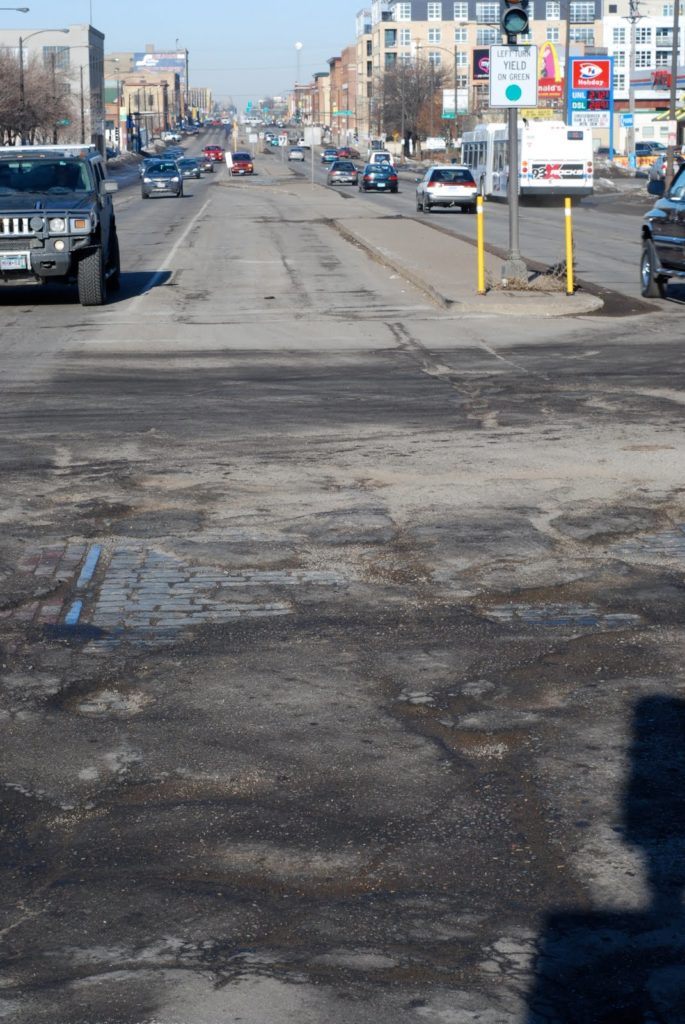About a week ago, Infrastructurist posted about the various
materials used for sidewalks. The consensus is that concrete is cheap and functional if not very environmentally friendly (both in its construction and its low permeability). Of course, in Paris, the streets are cobbled, which is
beautiful, if a bit
jarring to drivers and cyclists (although perhaps better than potholed asphalt).
Now, in America, except in a few instances (historic districts, or places where rich people gather, or both), streets are pavement. In some cases, concrete. Pavement is good when it’s good, but when it’s bad, it’s real bad. In other words, asphalt seems to have a wide range of conditions: new asphalt is silky smooth, but it doesn’t last in good shape. For a while it’s tolerable, until there’s a year with a lot of freeze-thaw cycles and gaps, gashes, frost heaves and, yes, potholes take over.
And that’s where we are in the Twin Cities. We’ve had an about-normal winter, but it’s been marked by a decent amount of warmer and colder temperatures. And snow. And plows. Minneapolis had enough snow accumulated that they had to
ban parking on one side of narrow streets to allow traffic to flow, and all over there are huge gaping holes in the streets. And that’s meant we get to see what lies beneath.
Here’s the middle of the intersection of
University Avenue and Vandalia Street in Saint Paul. University was once the main thoroughfare between Saint Paul and Minneapolis, and while most traffic now takes the paralleling I-94, it is home to buses and will, in a few years, be home to the
Central Corridor Light Rail. Of course, University had a
streetcar line, which was very well patronized (the buses still run at 10-plus minute headways, with limited service at rush hours) until it was closed in favor of buses in the early 1950s.
But 55 years later, the streetcar tracks, at least, are making a (re)appearance. The Google Street View from a couple years ago shows
solid pavement at the corner of Vandalia and University. However, Vandalia is the route to the interstate for many trucks serving the nearby industrial area, as well as going to a large BNSF multi-modal facility, and the corner sees a lot of heavy traffic. So with the current winter, the pavement has been torn up pretty well.
It’s actually not bad to drive on—the holes are wide enough that they aren’t all that deep (the sides generally slope) but so much pavement is gone that you can see the streetcar tracks as well as the pavement. And it’s really quite interesting. First of all, for such a wide road, the streetcar tracks really take up a small amount of room. The image above shows that the tracks are contained in a lane-and-a-half of a turn lane and median (no comment on how ugly the University streetscape is), and there are two lanes of traffic and a wide parking lane on either side.

But second, it gives us a really good idea of what streets used to look like. Here’s a closer-up look at the exposed section. The rail on the left is the southern rail of the eastbound track, the rail visible to the right is the southern rail of the westbound track. So, between the tracks were (are) gray cobblestones, and on the outside red brick. There isn’t much color film from the time, but it seems that University, with red and gray stone and silver, steel rails would be almost elegant (some trees would be nice as well). Now, with gray, gray and more gray, it’s quite drab.

Apparently bricks and cobbles don’t hold up well to heavy truck traffic, although this section seems to be doing just fine. Apparently bricks and cobbles were used along streetcar routes because they could be more easily picked up and laid down when track work was necessary. Of course, there’s a possibly apocryphal tale that Melbourne, Australia’s
trams were saved when, in the ’50s, the tracks were set in concrete, so that ripping them up would be prohibitive (in the US they were mostly just paved over). The union’s intransigence there—they required two-man operation on buses, and streetcars had conductors until the 1990s, when their removal
caused a crippling strike (long story short: government says “one person tram operation”, union says “no” and runs trams without collecting fares, government plans to cut power to the system, union drives trams on to streets in city center, where they sit for a month)—was probably more to blame.
When Lake Street was rebuilt in Minneapolis in 2005, the street below was in similar shape—shoddy asphalt over a firm streetcar base. Since it was not just repaved, it was dug up completely, and Twin Citians flocked to
scavenge bricks from below. University, which is wider and longer than Lake Street, should be a field day for anyone who wants a new, free patio or walk—it will be fully rebuilt for the light rail line (yes, they’ve studied it, and they can’t just reuse the tracks already there).
But, why not build streets out of these materials again? The upside to pavement is that, for a while, you have a really nice road. But in the long run? You have ruts, dips and potholes. Another layer of pavement is a panacea; cracks almost always form where there were cracks before (it’s easy to find old streetcar tracks—they’re wherever there are parallel cracks running down the road). Bricks and cobbles are attractive and permeable. Water filters through, which is better for the environment. As long as there’s no heavy truck or bus traffic, they’re fine. If something goes wrong, it’s easy to make small repairs which actually last (as opposed to patches which tear out during the next thaw). And for cyclists, constant cobbles are almost better than old pavement with huge potholes and ruts, even if you have a good bunny hop.
I’m not saying it’s the way to go for every street, but in certain cases—especially if there are
streetcars involved, red bricks and granite pavers may be the way to go. And in many cases, they may be lurking just below the surface already.







